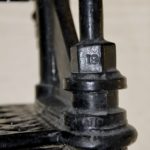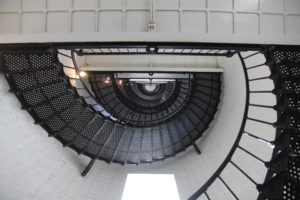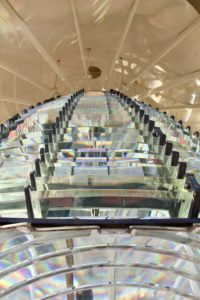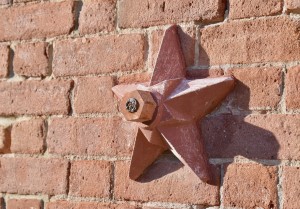As you might imagine, visitors to the St. Augustine Lighthouse are often excited about climbing the tower and enjoying the amazing panoramic view from 140 feet in the air. But in your excitement to climb the 219 steps to the top, you may overlook many small details that reveal some interesting stories of the Lighthouse. And if climbing the tower is your only concern, then there are many other details you will miss in and around the Keepers’ House and grounds. Next time you visit, see if you can spot some of these staff favorites.
1. Stair markings
It is quite a climb up 219 steps to the observation deck, also called the “gallery.” Eager to complete the climb, you could easily miss the first item on our list. If you look very closely, you will find small numbers and letters on the iron staircase.
The iron staircase arrived at the Lighthouse in parts and was assembled on site. To make sure the construction workers put the staircase together properly, each part had a number or letter imprinted on it. The workers building the Lighthouse had only to put them together in the correct order, like a huge iron set of Ikea furniture. Today, the numbers and letters are difficult to find. They are small and the ones under the black paint of the stairs are obviously hard to see in the lower light of the tower. However, the careful observer may still be able to pick them out on the climb to the top.
2. Clockwork evidence
Today, an electric motor turns the 2-ton, first order Fresnel lens at the top of the Lighthouse. Before 1936, the rotation of the lens was accomplished with a clockwork mechanism. It consisted of a large 270-pound weigh in the bottom of the tower attached by a cable to the top by a cable. At the top, the cable wrapped around a metal drum. The keeper would crank this drum and raise the weight as the cable wrapped around the drum. When the weight fell, it rotated the drum, which turned gears that turned the lens.
 The clockwork mechanism is long gone, but evidence of its presence still exists. The weight well, where the weight would sit, is still in the bottom of the tower. The guide loops for the cable are on each landing down the center of the tower. With the clockwork mechanism removed, it can be easy to overlook these features, whose purposes are no longer obvious.
The clockwork mechanism is long gone, but evidence of its presence still exists. The weight well, where the weight would sit, is still in the bottom of the tower. The guide loops for the cable are on each landing down the center of the tower. With the clockwork mechanism removed, it can be easy to overlook these features, whose purposes are no longer obvious.
3. Fresnel lens viewing
The Lighthouse’s Fresnel lens is a massive assembly of glass and brass and is understandably in an enclosed, protected space at the top of the tower. Access is limited to required maintenance and special circumstances. The only chance for a visitor to go in the Lens Room is on the aptly-named Lens Room Tour.
Despite its protected location, there is a great viewing area for the Fresnel lens that many visitors don’t notice. At the top of the iron staircase, visitors have a choice. Most people opt to take a left turn and step out onto the observation deck of the Lighthouse. Of course, this is an excellent choice as the view is amazing. But if you instead decide to keep walking straight at the top of the stairs, just a few more steps will take you to a wonderful floor-to-ceiling viewing area for the Fresnel lens. You can see inside the lens and get an appreciation for the work that went into making and operating this optical marvel.
4. Anchor Plates
You will often find anchor plates on the outer walls of brick buildings. They work in pairs, with one attached at each end of a long metal rod called a tie rod. The tie rod runs the length or width of the building and the two anchor plates cap the end of the tie rod, effectively holding the brick walls together. This keeps the walls from bowing outward or eventually collapsing under the weight of the building. Many anchor plates are added well after construction to prevent continued wall movement, which is why you might  sometimes spot anchor plates on old brick buildings that are not spaced evenly.
sometimes spot anchor plates on old brick buildings that are not spaced evenly.
The eight star anchor plates on the Keepers’ House are easy to miss as they are the same color as the brick wall and they are on the north and south sides of the building, away from the more popular visitor areas.
5. Cistern
The basement of the Keepers’ House is currently occupied by our Wrecked! exhibit. It tells the story of a British loyalist shipwreck from 1782 found by the Lighthouse’s maritime archaeologists. As you go through the exhibit, discovering the many unique artifacts from the shipwreck, you may miss one important feature of the basement itself. It dates back to a time before running water, when the keepers and their families relied on the water falling from the sky for drinking, cleaning, and bathing.
The cistern consists of two enclosed brick rooms with no doors and only one high window each. The rain would fall on the roof and drain into the cistern through a series of gutters and pipes. Other pipes would then allow the keepers to pump the water back out of the tanks. Indoor plumbing arrived at the Keepers’ House in 1907, so the pipes are no longer there. However, an observant visitor would be able to spot the holes in the wall where the pipes brought water from outside into the cistern tank.
There are many more hidden features here at the St. Augustine Lighthouse & Maritime Museum and I hope that you can find these and others on your next visit.
Paul Zielinski is Director of Interpretation for the St. Augustine Lighthouse & Maritime Museum. He received his master’s degree in Public History from the University of West Florida and joined the lighthouse family in 2011.

